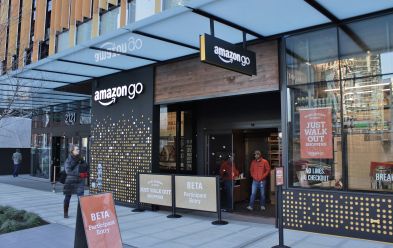Video by Renin Broadnax.
On Monday, Jan. 23, the first Amazon Go store had its grand opening in downtown Seattle. Since then, shoppers have had the time to get comfortable exiting the store without pulling out their wallets to pay and not feel like they are shoplifting.
The store uses the latest available technology. Upon entering, customers use the Amazon Go app to scan in, similar to a MetroCard on the subway or scanning our student ID when picking up lunch on our campus cafeteria. Once that glass gate opens, customers are free to browse and peruse at their leisure. With no shopping cart, customers can store all their merchandise in their canvas Amazon Go bags or their own backpacks. Customers then leave the store and are automatically charged on their app.
Some customers who have traveled to the Seattle area witnessed the new store firsthand. Brandon Beadel, a Texas resident and privacy specialist for IBM, was one of these individuals. Through Facebook messaging, he explained how surreal the store felt.

“It was surreal, just walking around, picking things up off of shelves, putting them back, putting them in bags and knowing that it was keeping track of it,” Beadel said. “The ceiling had a huge array of cameras and sensors and there was a cool but somewhat creepy feeling of being watched.”
Pressure sensors are located on every store shelf to track the merchandise that is taken or placed back. Dozens of cameras hang off of the ceiling and digitally scan any packaged food items and café snacks, while the more general merchandise is simply identified and tracked in a virtual basket until customers leave the store. The amazon app tracks those purchased items and displays the customer’s receipt after shopping is done.
“I like the innovation and technical background behind the concept. It feels a bit magical that everything’s running automatically, but when you look up and see all the cameras, you’ve got the explanation,” Max Millian, an operations manager for global logistics, said.
With just a taste of how this new system operates, people have raised questions as to how the store will handle problems moving forward. Many are trying to picture a future in which more stores reach this level of technology and see it for themselves in their neighborhoods.
One concern with Amazon Go is if it will end up killing jobs. The reality is the staff may no longer be cashiers, but plenty of other work is available and needed for running the store. Shelves still need to be stocked, ID’s still need to be checked for purchasing alcohol, chefs are still preparing food. The technology within the store also has to be closely monitored and shoppers will still need assistance.
Another concern is how the store would handle a glitch in the system or a security breach.
Dave Bell, a marketing professor at the University of Pennsylvania’s Wharton School, said to the Chicago Tribune, “Is it still shoplifting if it’s not the customer’s fault?”
The only answer at the moment is that the occasional glitch or system error would still be nothing compared to that of the usual shoplifting or thefts that do take place in a regular store. In other words, the possibility of not having an item accounted for and charged would be the same as any other new-age technical glitch, such as getting someone’s online delivery wrong.
There are also questions of Amazon Go replacing a traditional grocery store setting. This is not the case at all either.
The Seattle store is 1800 square feet, and any other stores that come up are not expected to grow much in space either.
“It’s good if you want to grab just a few products. It’s very convenient and ultra fast,” Millian said.
There were features customers did not enjoy or feel Amazon could do better.
“The thing I liked the least is it completely removes human interaction. It was very busy, but it was eerily quiet in there,” Beadel said. “I think there’s still a need to have human employees. Makes it feel less antisocial. If Amazon plans on having the people at the exit giving you the reassurance that you are okay to leave not be there permanently, then Amazon needs to find functionality in replacing that. It was the only thing that made you feel like you weren’t stealing. I got my receipt on my phone before I got very far, but it still took a few minutes. I’m sure they can find a way to speed that up a bit.”
Millian brought up a similar concern.
“In total, I think amazon did a good job,” Millian said. “Maybe they could offer more products, but I see this first store as a test-drive, so it’s fine how it is. The loss of manpower and working personnel is a totally different aspect, which can be seen quite critical, but that would go too far.”


